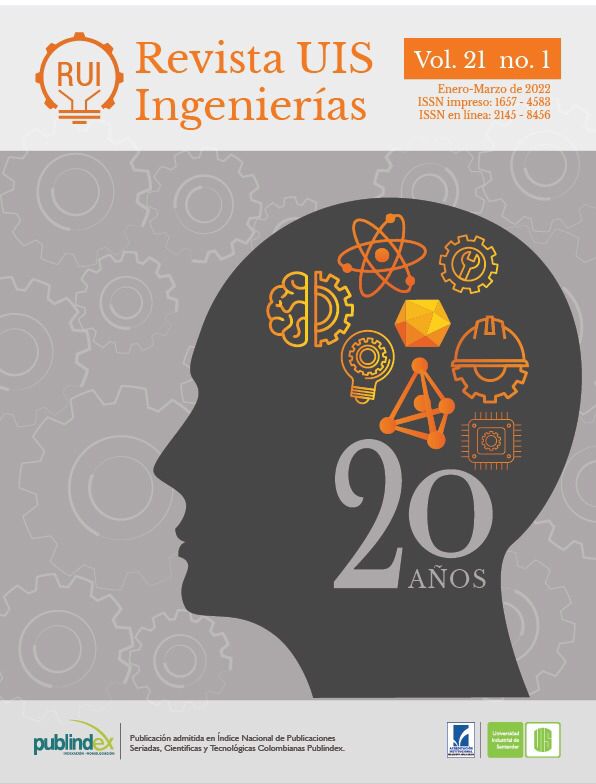Performance evaluation of an engine-generator set operating on high butane content LPG fuel
Published 2022-01-14
Keywords
- combustion engine,
- high butane LPG,
- test protocol,
- operation diagnostics,
- warm-up time
- transient performance,
- dynamic stability,
- vibrations,
- exhaust pollutant emissions,
- generated power quality ...More
How to Cite
Copyright (c) 2022 Revista UIS Ingenierías

This work is licensed under a Creative Commons Attribution-NoDerivatives 4.0 International License.
Abstract
This paper presents the results of the performance diagnosis of a 6-cylinder engine-generator set, originally designed to run on diesel fuel or natural gas, operating in spark ignition mode and fueled with high butane content liquefied petroleum gas (LPG). In order to assess the steady-state and transient operation of the engine-generator, an original protocol for testing and recording of operating variables was designed, based on a stepped sequence of loads, comprising cold start, idling, operation at some mean load points and at a limited full load. During the tests, the variation of crankshaft rotational speed, warm-up time, engine temperatures, block vibrations, active/reactive power and engine-generator frequency, as well as exhaust emissions were continuously logged. The results show that, during the cold starting process, the engine is slow to reach nominal rated speed, its warm-up time is lengthy and its speed response during load transients is also sluggish, the latter being reflected in the voltage and frequency deviations of the output power; also, during transients, vibration levels are intensified, though the values are within the acceptable ranges according to the regulations. The torque performance of the engine-generator set is good when operating with LPG, satisfying the requirements for class G2 engine-generator units, but during transient processes it does not meet the specifications required for class G1, in terms of frequency and voltage deviations. In light of the emission limits suggested by the Environmental Protection Agency (EPA) for stationary units, it can be concluded that, without appropriate adjustments and regulations particular to LPG, the engine-generator set does not meet the carbon monoxide emission limits.
Downloads
References
- Reglamento técnico aplicable al recibo, almacenamiento y distribución de gas licuado de petróleo, GLP, Ministerio de Minas y Energía, Resolución 40246 de 7 de marzo de 2016.
- Cadena del gas licuado del petróleo (GLP), Unidad de Planeación Minero Energética, UPME, 2017.
- E. P. Johnson, “Carbon footprints of heating oil and LPG heating systems”, Environmental Impact Assessment Review, vol. 35, p 11-22, 2012, doi: https://doi.org/10.1016/j.eiar.2012.01.004.
- “LPG code”, National Fire Protection Association, NFPA 58, 2011. [En línea]. Disponible en: https://www.nfpa.org/Assets/files/AboutTheCodes/58/FI58-2011.pdf
- H. E. Saleh, “Effect of variation in LPG composition on emissions and performance in a dual fuel diésel engine”, Fuel, vol. 87, pp. 3031 – 3039, 2008, doi: https://doi.org/10.1016/j.fuel.2008.04.007.
- M. P. Poonia, A. Ramesh, R. R. Gaur. “Experimental investigation of the factors affecting the performance of an LPG-diésel dual fuel mode”, SAE Technical Paper, 1999-01-1123, 1999, doi: https://doi.org/10.4271/1999-01-1123.
- C. S. Mistry, C. K. Pithawalla, “Comparative Assessment on Performance of Multi cylinder Engine Using CNG, LPG and Petrol as a Fuel”, SAE Technical Paper, 2005-01-1056, 2005, doi: https://doi.org/10.4271/2005-01-1056.
- A. H. Pundkar, S. M. Lawankar, S. Deshmukh, “Performance and Emissions of LPG Fueled Internal Combustion Engine: A Review”, International Journal of Scientific & Engineering Research, vol. 3, Issue 3, 2012.
- Reciprocating internal combustion engines - Exhaust emission measurement, ISO 8178:2002.
- Internal combustion engines - Determination and method for the measurement of engine power -- General requirements, ISO 15550:2002.
- Reciprocating internal combustion engine driven alternating current generating sets - Part 1: Application, ratings and performance, ISO 8528-1:2005.
- Reciprocating internal combustion engines – Performance, ISO 3046:2002.
- Cummins Engine Company, Inc. G-Drive C8.3. 6CTA8.3-G2 Engine Data Sheet, 1999.
- Cummins Westport fuel quality, Cummins Westport. calculator, 2019. [En línea]. Disponible en: http://www.cumminswestport.com/fuel-quality-calculator.
- Reference Guide, ComAp Electronic Engines Support, 2011.
- B. Meisner. “EPA Emission Standards for Diesel generators”, Power System Topics, vol. 124, 2020. [En línea]. Disponible en: http://resources.kohler.com/power/kohler/industrial/pdf/Emission_Std_White_Paper.pdf.
- Emission Standards Reference Guide, U.S. Environmental Protection Agency, 2021. [En línea]. Disponible en: https://www.epa.gov/emission-standards-reference-guide/epa-emission-standards-nonroad-engines-and-vehicles.
- Reciprocating internal combustion engine driven alternating current generating sets - Part 9: Measurement and evaluation of mechanical vibrations, ISO 8528-9:2017.
- Mechanical Vibration - Evaluation of machine Vibration by measurements on nonrotating, Part 6 - Reciprocating machines with power ratings above 100 kW, ISO 10816-6: 1995.
- Ł. Warguła, M. Kukla, P. Lijewski, M. Dobrzynski, F. Markiewicz, “Influence of the Use of Liquefied Petroleum Gas (LPG) Systems in Woodchippers Powered by Small Engines on Exhaust Emissions and Operating Costs”, Energies, vol. 13, 2020, doi: https://doi.org/10.3390/en13215773.
- F. Synák, K. Čulík, V. Rievaj, J. Gaňa. “Liquefied petroleum gas as an alternative fuel”, Transportation Research Procedia, vol. 40, 527–534, 2019, doi: https://doi.org/10.1016/j.trpro.2021.02.012.
- A. Ngang, N. Abbe, “diesesss”, Applied Thermal Engineering, vol. 136, pp.462-474, 2018, doi: https://doi.org/10.1016/j.applthermaleng.2018.03.022.

